![]()
![]()
![]()
Use LEFT and RIGHT arrow keys to navigate between flashcards;
Use UP and DOWN arrow keys to flip the card;
H to show hint;
A reads text to speech;
72 Cards in this Set
- Front
- Back
- 3rd side (hint)
|
Axial Skeleton
|
part of the skeleton that consist of the bones of the head and the trunk of a vertebra
|
|
|
|
Cartilage
|
A firm, elastic, flexible type of connective tissue of a translucent whiteish or yellowish color gristle
|
|
|
|
Closed Circulatory System
|
Where the blood remains contained within vessels
|
|
|
|
Mammary Glands
|
Produces milk and offspring feeds on this nutritious milk
|
|
|
|
Endothermic
|
Animal whose main source of body heat is generated from cell metabolism
|
|
|
|
Ectothermic
|
Animals whose main source of body heat is the external environment
|
|
|
|
Amniote egg
|
A waterproof egg with the shell
|
|
|
|
Metamorphosis
|
Larvae undergoes a change of body form
|
|
|
|
Keel
|
A ridge along the breastbone of many birds to which the flight muscles are attached; the Carnia
|
|
|
|
Bone
|
Whitish tissue making up the skeleton in humans and other vertebrae
|
|
|
|
Vertebrae
|
The backbone composed of a series of skeleton segments which encloses the nerve cord
|
|
|
|
Notachord
|
A flexible rod that extends through much of the length of the body
|
|
|
|
Feathers
|
are modified scales that are made of keratin
|
|
|
|
Scales
|
Hard overlapping structures made of keratin
|
|
|
|
Cephlaochordata
|
Chordata subphylum; the presence of a notochord that persist throughout life
|
|
|
|
Agnatha
|
The class of vertebrates comprising the lamprey, hagfish, and several extinct forms, having no jaws or paired appendages
|
|
|
|
Osteichthyes
|
The class comprising the bony fish
|
|
|
|
Aves
|
The class of birds
|
|
|
|
What do all Chordates have in common?
|
A hollow nerve cord, slits in the Pharynx and gills
|
those 3 characteristics
|
|
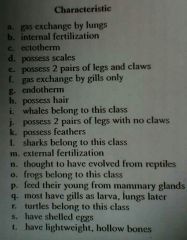
Which characterize "Cartilaginous Fish"
|
L, D, F, and B
|
|
|
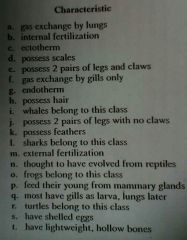
Which characterize "Bony Fish"
|
F, D, C, M, and P
|
|
|

Which characterize "Amphibians"
|
O, C, and Q
|
|
|
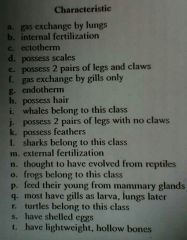
Which characterize "Reptiles"
|
S, M, R, and C
|
|
|
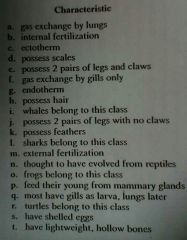
Which characterize "Birds"
|
T, A, K, N, G, and S
|
|
|
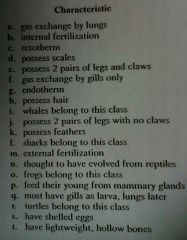
Which characterize "Mammals"
|
H, P, I, and G
|
|
|

Vertebrates are subdivided into (three) major groups.
|
False Seven
|
|
|

Lampreys are examples or jawless (fish).
|
True
|
|
|

Bony Fish have (exposed gills).
|
False Operculum
|
|
|

The first animals to evolve legs were (birds).
|
True
|
|
|

(Reptiles) spend part of their life cycle in water, part on land.
|
False Amphibians
|
|
|

Only birds and one form of (mammal) are capable of sustained flight
|
True
|
|
|

A high level of activity can be maintained by (ectotherms).
|
False Endotherms
|
|
|

Only (mammals) can provide their offspring with a readily available food source.
|
true
|
|
|
|
Name the Kingdom, Domain, Class, Phylum, of Birds
|
K: Animalia D: Eukoryote C: Aves P: Chordata
|
|
|
|
Name the Kingdom, Domain, Class, and Phylum, of Sharks
|
K: Animalia D: Eukaryote C: Chondrichthyes P: Chordata
|
|
|
|
Name the Kingdom, Domain, Class, and Phylum, of Bony Fish
|
K: Animalia D: Eukaryote C: Osteichthyes P: Chordata
|
|
|
|
Name the Kingdom, Domain, Class, Phylum, of Frogs
|
K: Eukaryote D: Animalia C: Amphibia P: Chordata
|
|
|
|
(23.8)
Echinoderm |
They lack body segments, and in most adults form the external parts of the animal radiate from the center like spokes on a wheel.
|
|
|
|
(23.8)
Endoskeleton |
The spines and plates are actually parts of a hard internal skeleton.
|
|
|
|
(23.8)
Water Vascular System |
A network of water-filled canals
|
|
|
|
(23.8)
Tube feet |
The water vascular system branches into structures that function in locomotion, feeding, and respiration.
|
|
|
|
(23.8)
Protostomes |
The coelom forms from solid masses of cells in the embryo
|
|
|
|
Marsupial
|
Embryos born undeveloped then crawl into a pouch
|
|
|
|
placental animals
|
develop in uterus. Amnion- protective membrane
|
|
|
|
Mammalia
|
Have mammary glands; are exothermic; have hair, and four chambered heart
|
|
|
|
Monotremes
|
Lay eggs.
Example is a duckbill platypus |
|
|
|
precocial birds
|
•well developed when hatched
•lay high number of eggs |
|
|
|
alitrital birds
|
•highly dependent when young
•1-3 eggs |
|
|
|
birds energy facts
|
-endothermic
-air sacs, oxygen for cellular respiration -4 chambered heart -eat 2-3x body weight |
|
|
|
lightweight facts if birds
|
-feathers
-hallow bones -no urinary bladder -females have one ovary -no teeth -beak made of keratin :lay eggs |
|
|
|
General characteristic of reptiles
|
scaly skin
most lay eggs waterproof skin many molt |
|
|
|
reptile examples
|
turtles,lizards,snakes,crocodiles
|
|
|
|
turtles-reptiles
|
-large shell of bony plates covered by scales
-some terrestrial |
|
|
|
lizards and snakes
|
4legs-reptiles
ectothetms Insect mainly diet |
|
|
|
salamanders
|
-500 species
-long slender bodies -tail -scurry .meat eaters |
|
|
|
caecilians
|
- 150 species
-legless -nearly blind -burrow in ground |
|
|
|
amniotes
|
reptiles, birds, mammals
|
|
|
|
tetropods
|
amphibians
|
|
|
|
amphibians
|
live part of life on land, part in water
|
|
|
|
larval stage of amphibians
|
-water
-gills -2 chambered heart -lateral line |
|
|
|
adault stage of amphibians
|
land
3 chambered heart |
|
|
|
tadpoles
|
legless
plant eaters lateral line system aquatic gills long fin tail |
|
|
|
frogs
|
bulging eyes
no tail strong hind legs webbed feet smooth moist skin mainly eats insects |
|
|
|
vertabrate
|
backbone
rib cage skull girdles limb bones appendicular skeleton skeleton of bones/cartilage well developed nervous system closed circulatory system |
|
|
|
urochordata
|
sea squirts
jelly like slits on side of tube sessile filter feed |
|
|
|
cephalochordates
|
keep all 4 charecterics
|
|
|
|
lobe finned fish
|
muscular fins
not common today |
|
|
|
Ray finned fish
|
trout,bass,perch,tuna
bony fin swim bladder |
|
|
|
General characteristic of bony fish
|
operculum
lateral line system keen smell scales cover skin good eyesight most carnivores air sacs two chambered heart |
|
|
|
rays
|
bitten dwellers
use jaws to crush mollusks enlarged front fins whip like tails |
|
|
|
sharks
|
Marine
dorsal is stabalizer predator Sharp eyesight powerful sense of smell highly developed electro sense lateral line system |
|
|
|
what are characteristic of the Kingdom Animalia
|
1. Eukaryotic
2. Multicellular 3. Organ System 4. Motile 5. Heterotrophic 6. Has Cell Membrane |
|

